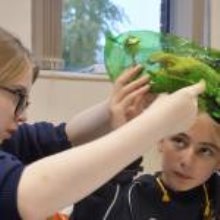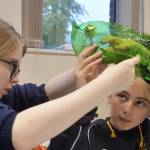
This week, Year 9 students got creative in Biology in a very imaginative task set by Mr Rodrigues to make 3D models of a specific cell – either a sperm, cone, root hair or fat cell. With an array of recycled materials such as pipe cleaners, coloured paper, cardboard and polystyrene balls, students took on the task of making their cells come to life in the most efficient, aesthetic and scientific ways possible.
One team were tasked with creating a fat cell and had an innovative idea to use green plastic wrapping to create the cell membrane and a lid to represent the nucleus; throughout the construction process, the team were able to properly identify the specifics of the cell and had a better understanding of the way it works by seeing it in a 3D model. Another team, grappled with constructing a cone cell and used a mixture of straws, coloured paper and an egg container to create their cell with detailed annotations and how the cell functions.
As the clock ticked down, seven fantastic creations were laid out for the judges with the criteria being to have made a realistic, scientifically correct, interesting model using the right choice of materials. After each student voted, first prize went to a group who had constructed a very detailed cone cell!
It was a fantastic lesson where students were able to gain a firm understanding of how cell works and how they adapt to their function. A great way to teach this very important part of Biology and one that is sure to remain in students’ memory!





.jpg?command_1=resize&width_1=260&height_1=345)




















